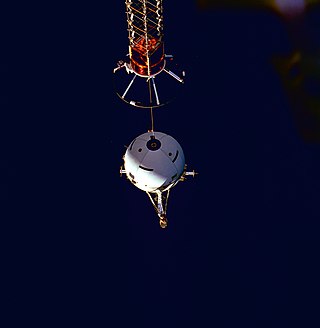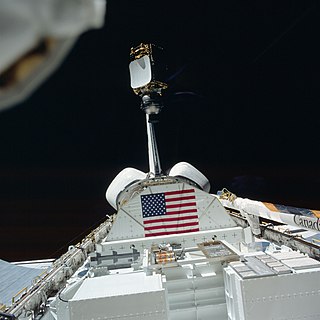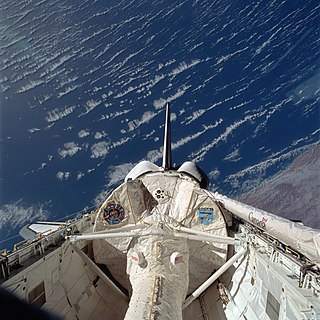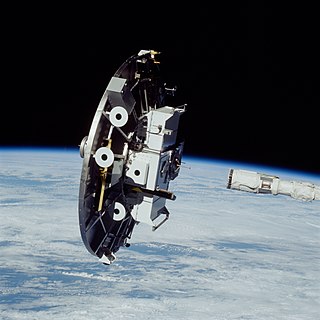Related Research Articles

STS-51-F was the 19th flight of NASA's Space Shuttle program and the eighth flight of Space Shuttle Challenger. It launched from Kennedy Space Center, Florida, on July 29, 1985, and landed eight days later on August 6, 1985.

STS-2 was the second Space Shuttle mission conducted by NASA, and the second flight of the orbiter Columbia. The mission, crewed by Joe H. Engle and Richard H. Truly, launched on November 12, 1981, and landed two days later on November 14, 1981. STS-2 marked the first time that a crewed, reusable orbital vehicle returned to space. This mission tested the Shuttle Imaging Radar (SIR) as part of the OSTA-1 payload, along with a wide range of other experiments including the Shuttle robotic arm, commonly known as Canadarm. Other experiments or tests included Shuttle Multispectral Infrared Radiometer, Feature Identification and Location Experiment, Measurement of Air Pollution from Satellites, Ocean Color Experiment, Night/Day optical Survey of Lightning, Heflex Bioengineering Test, and Aerodynamic Coefficient Identification Package (ACIP). One of the feats accomplished was various tests on the Orbital Maneuvring System (OMS) including starting and restarting the engines while in orbit and various adjustments to its orbit. The OMS tests also helped adjust the Shuttle's orbit for use of the radar. During the mission, President Reagan called the crew of STS-2 from Mission Control Center in Houston.

STS-31 was the 35th mission of NASA's Space Shuttle program. The primary purpose of this mission was the deployment of the Hubble Space Telescope (HST) into low Earth orbit. The mission used the Space Shuttle Discovery, which lifted off from Launch Complex 39B on April 24, 1990, from Kennedy Space Center, Florida.

STS-75 was a 1996 NASA Space Shuttle mission, the 19th mission of the Columbia orbiter.

STS-41-C was NASA's eleventh Space Shuttle mission, and the fifth mission of Space Shuttle Challenger. The launch, which took place on April 6, 1984, marked the first direct ascent trajectory for a Space Shuttle mission. During the mission, Challenger's crew captured and repaired the malfunctioning Solar Maximum Mission satellite, and deployed the Long Duration Exposure Facility (LDEF) experimental apparatus. STS-41-C was extended one day due to problems capturing the Solar Max satellite, and the landing on April 13, 1984, took place at Edwards Air Force Base, instead of at Kennedy Space Center as had been planned. The flight was originally numbered STS-13.

STS-8 was the eighth NASA Space Shuttle mission and the third flight of the Space Shuttle Challenger. It launched on August 30, 1983, and landed on September 5, 1983, conducting the first night launch and night landing of the Space Shuttle program. It also carried the first African-American astronaut, Guion Bluford. The mission successfully achieved all of its planned research objectives, but was marred by the subsequent discovery that a solid-fuel rocket booster had almost malfunctioned catastrophically during the launch.

STS-41-B was NASA's tenth Space Shuttle mission and the fourth flight of the Space ShuttleChallenger. It launched on 3 February 1984, and landed on 11 February 1984 after deploying two communications satellites. It was also notable for including the first untethered spacewalk.

STS-41-G was the 13th flight of NASA's Space Shuttle program and the sixth flight of Space Shuttle Challenger. Challenger launched on October 5, 1984, and conducted the second shuttle landing at Kennedy Space Center on October 13, 1984. It was the first shuttle mission to carry a crew of seven, including the first crew with two women, the first American Extravehicular activity (EVA) involving a woman (Sullivan), the first Australian-born person to journey into space as well as the first astronaut with a beard and the first Canadian astronaut.

STS-61-A was the 22nd mission of NASA's Space Shuttle program. It was a scientific Spacelab mission, funded and directed by West Germany – hence the non-NASA designation of D-1. STS-61-A was the ninth and last successful flight of Space Shuttle Challenger before the disaster. STS-61-A holds the current record for the largest crew—eight people—aboard any single spacecraft for the entire period from launch to landing.

STS-61-C was the 24th mission of NASA's Space Shuttle program, and the seventh mission of Space Shuttle Columbia. It was the first time that Columbia, the first space-rated Space Shuttle orbiter to be constructed, had flown since STS-9. The mission launched from Florida's Kennedy Space Center on January 12, 1986, and landed six days later on January 18, 1986. STS-61-C's seven-person crew included the first Costa Rican-born astronaut, Franklin Chang-Díaz, and 2 future Administrators of NASA: the second African-American shuttle pilot, Charles Bolden, and the second sitting politician to fly in space, Representative Bill Nelson (D-FL). It was the last shuttle mission before the Space Shuttle Challenger disaster, which occurred ten days after STS-61-C's landing.

STS-29 was the 28th NASA Space Shuttle mission, during which Space Shuttle Discovery inserted a Tracking and Data Relay Satellite (TDRS) into Earth orbit. It was the third shuttle mission following the Challenger disaster in 1986, and launched from Kennedy Space Center, Florida, on March 13, 1989. STS-29R was the eighth flight of Discovery and the 28th Space Shuttle mission overall; its planned predecessor, STS-28, was delayed until August 1989.

STS-30 was the 29th NASA Space Shuttle mission and the fourth mission for Space Shuttle Atlantis. It was the fourth shuttle launch since the Challenger disaster and the first shuttle mission since the disaster to have a female astronaut on board. The mission launched from Kennedy Space Center, Florida, on May 4, 1989, and landed four days later on May 8, 1989. During the mission, Atlantis deployed the Venus-bound Magellan probe into orbit.

STS-37, the thirty-ninth NASA Space Shuttle mission and the eighth flight of the Space Shuttle Atlantis, was a six-day mission with the primary objective of launching the Compton Gamma Ray Observatory (CGRO), the second of the Great Observatories program which included the visible-spectrum Hubble Space Telescope (HST), the Chandra X-ray Observatory (CXO) and the infrared Spitzer Space Telescope. The mission also featured two spacewalks, the first since 1985.

STS-43, the ninth mission for Space Shuttle Atlantis, was a nine-day mission whose primary goal was launching the TDRS-E satellite (TDRS-5). The flight also tested an advanced heatpipe radiator for potential use on the then-future space station and conducted a variety of medical and materials science investigations.

STS-42 was a NASA Space Shuttle Discovery mission with the Spacelab module. Liftoff was originally scheduled for 8:45 EST on January 22, 1992, but the launch was delayed due to weather constraints. Discovery successfully lifted off an hour later at 9:52:33 EST. The main goal of the mission was to study the effects of microgravity on a variety of organisms. The shuttle landed at 8:07:17 PST on January 30, 1992, on Runway 22, Edwards Air Force Base, California. STS-42 was the first of two flights in 1992 of Discovery, the second of which occurred during STS-53, which launched on December 2, 1992. The mission was also the last mission of the Space Shuttle Discovery to have a seven-member crew until STS-82, which was launched on February 11, 1997.

STS-49 was NASA's maiden flight of the Space Shuttle Endeavour, which launched on May 7, 1992. The primary goal of its nine-day mission was to retrieve an Intelsat VI satellite, Intelsat 603, which failed to leave Low Earth orbit two years before, attach it to a new upper stage, and relaunch it to its intended geosynchronous orbit. After several attempts, the capture was completed with the only three-person extravehicular activity (EVA) in space flight history. It would also stand until STS-102 in 2001 as the longest EVA ever undertaken.

STS-47 was NASA's 50th Space Shuttle mission of the program, as well as the second mission of the Space Shuttle Endeavour. The mission mainly involved conducting experiments in life and material sciences inside Spacelab-J, a collaborative laboratory inside the shuttle's payload bay sponsored by NASA and the National Space Development Agency of Japan (NASDA). This mission carried Mamoru Mohri, the first Japanese astronaut aboard the shuttle, Mae Jemison, the first African-American woman to go to space, and the only married couple to fly together on the shuttle, Mark C. Lee and Jan Davis, contrary to NASA policy.

Henry Warren Hartsfield Jr. was a United States Air Force Colonel and NASA astronaut who logged over 480 hours in space. He was inducted into the United States Astronaut Hall of Fame in 2006.

STS-57 was a NASA Space Shuttle-Spacehab mission of Space ShuttleEndeavour that launched June 21, 1993, from Kennedy Space Center, Florida.

STS-80 was a Space Shuttle mission flown by Space Shuttle Columbia. The launch was originally scheduled for October 31, 1996, but was delayed to November 19 for several reasons. Likewise, the landing, which was originally scheduled for December 5, was pushed back to December 7 after bad weather prevented landing for two days.
References
- ↑ Robert A. Freitas Jr., Sex in Space Archived 2008-12-24 at the Wayback Machine , author's commentary on an article originally published in Sexology Today 48 (April 1983), 58–64
- ↑ Sex in Space?, reposted by Bill Ward, July 30, 2001 (this reposting preserves the original text and original posting date, unlike many other repostings)
- ↑ Roach, Mary (2011). Packing For Mars. W. W. Norton & Company. pp. 235–236. ISBN 9780393339918. Archived from the original on 2017-02-25. Retrieved 2021-05-07.
- ↑ David Schmader, Last Days Archived 2007-12-10 at the Wayback Machine , The Stranger, February 22, 2000
- ↑ Pierre Kohler. La Dernière Mission (The Final Mission). Calmann-Levy, 2000 - ISBN 2-7021-3080-1.
- ↑ "The 100,000-Mile-High Club". Wired News. February 23, 2000. Archived from the original on 3 March 2003. Retrieved 27 October 2016.